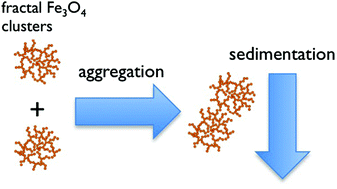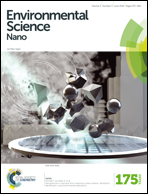Aggregation and sedimentation of magnetite nanoparticle clusters†
Abstract
Magnetite nanoparticles are redox active constituents of subsurface and corrosive environments. In this study, we characterized the aggregation and sedimentation behavior of well characterized magnetite nanoparticle clusters using dynamic light scattering (DLS), UV-vis-NIR spectroscopy, and small angle X-ray scattering (SAXS). Both unfunctionalized (NaOH-magnetite) and tetramethylammonium hydroxide (TMAOH-magnetite) surface functionalized nanoparticle clusters were employed. TMAOH-magnetite has a slightly smaller primary nanoparticle radius as determined by TEM (4 ± 0.7 nm vs. 5 ± 0.8 for NaOH-magnetite) and a smaller initial DLS determined cluster radius (<30 nm vs. 100–200 nm for NaOH-magnetite). Interestingly, in spite of its smaller initial nanoparticle cluster size, TMAOH-magnetite undergoes sedimentation more rapidly than NaOH-magnetite. This behavior is consistent with the more rapid aggregation of the smaller TMAOH-magnetite clusters as well as their lower fractal dimension, as determined by SAXS. This study illustrates that both nanoparticle cluster size and fractal dimension should be carefully considered when considering the environmental transport and fate of highly aggregated nanoparticles.



 Please wait while we load your content...
Please wait while we load your content...